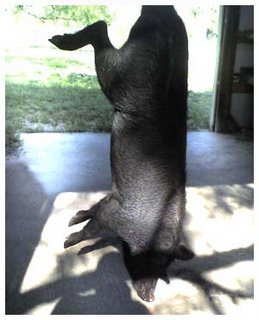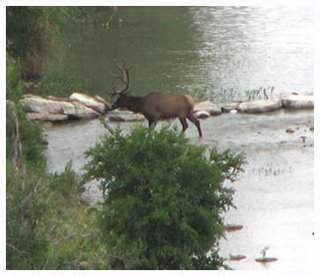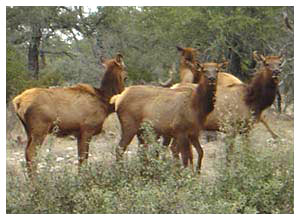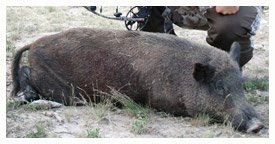Hunting Tips, Questions, Stories & Discussion
Focusing on managing Texas wildlife habitat and natural resources for native and exotic wild game species, for this and future generation of hunters and outdoor enthusiasts.Thursday, July 9, 2009
Hunting Report: July 4, 2009
It was a cool, low 70s, Saturday morning on July 4th (cool by South Central Texas standards). I parked the truck about 400 yards down the road and proceeded to Betty's blind (affectionately named after Escondido's gracious hostess). The wind was favorable and blowing 5-10 mph parallel to the ground blind and the feeder. The feeder is located 85 yards away from the blind near the wooded edge of a rocky slope leading several hundred feet to a spring below. This time of the year, South Central Texas is scorched by summer heat with day time temperatures hovering over 100 degrees. But earlier in the week, the ranch got 1.5 inches of well received rain and everything was unseasonably green.
It was already close to the shooting light by the time I got into the blind. Today, I was equipped with a 10x44 scope mounted on a brand new .270 rifle and the targets were the feral hog and the illusive aoudad sheep. In the past year, I have been a frequent guest at Escondido Ranch and have shot a number of feral hogs. However, in all of my outings at the ranch, I have seen a group of young aoudad sheep only once, at over 200 yards and moving across a narrow opening. There are certainly ample aoudad on the ranch, including a number of trophy animals. A couple of the trophy size mounts are proudly displayed in the main house, but the weary animals continue to elude me.
have shot a number of feral hogs. However, in all of my outings at the ranch, I have seen a group of young aoudad sheep only once, at over 200 yards and moving across a narrow opening. There are certainly ample aoudad on the ranch, including a number of trophy animals. A couple of the trophy size mounts are proudly displayed in the main house, but the weary animals continue to elude me.
I settled in for the morning hunt after practicing a few "air" shots with my rifle to make sure I was in a comfortable shooting position. Even before the feeder went off at 7 am, two whitetail does had made their way across the shooting lane from behind the blind towards the feeder. Both animals passed within 40 yards of me without so much as a second whiff or a cautionary pause, and then proceeded to feed on the green grass around the feeder. The does grazed effortlessly, knowing that they were not on a la carte this morning, and seemed to be oblivious to any accidental noises coming from the blind. A bit later another whitetail and a fallow doe joined the gathering, and proceeded to feed on both the green grass and the corn scattered around by the feeder. The fallow deer, a native of Europe, are also common at Escondido. The fallow bucks are crowned with a set of distinct horns resembling those of a moose, but on a smaller scale. The hides vary in color from pure white (as was this doe) to spotted reddish brown.
The fallow doe was much more alert than the whitetails. As an exotic, the fallow can be hunted year round in Texas. After 15 minutes of nervous feeding, the fallow zigzagged its way toward woods' edge and disappeared in the shadows. Meanwhile the whitetails continued to graze so carefree that one of them approached me to within meager 20 yards (a bow hunters dream).
As the sun ascended in the sky engulfing the tree tops in a brilliant light, I glanced at my watch. Remembering that I promised my wife to be back at the main house by 9am to help with the kids, who came with us for this 4th of July weekend, I decided to call it quits for the morning and started to pack up.
Once packed, with the gun unloaded, I was literally pushing open the door, when all of a sudden, a black feral hog appeared from the brush and trotted directly towards my hideaway. My heart started to pound. I eased the backpack to the floor, felt around my chest pocket for .270 round (130 grain), placed the bullet into the chamber and eased the bolt into the position. Thirty yards out, the hog stopped, lifted up its snout and sniffed the air with authority, grunting a couple of times in the process. Meanwhile, the three whitetail does stopped feeding and intently looked at the hog.
times in the process. Meanwhile, the three whitetail does stopped feeding and intently looked at the hog.
When I finally locked the bolt into place, the inevitable click of the mechanism must have sounded like a ringing bell to the nearby hog, which looked in my direction and quickly turned sideways and began to pick up speed. The rest was a blur... I raised my rifle, somehow found the hog in the scope, instinctively aimed behind the shoulder while thinking that he was too close and does not need to be lead, removed the safety and pulled the trigger.
The shot rang out and through the dissipating cloud of gun smoke, I could see the hog fall on its back and after a few leg twitches rolled over on its side and came to a rest. I jammed another round in the chamber, pushed open the door and quickly walked towards the still hog. It was dead. The bullet entered at a slight angle behind the left shoulder and exited a bit forward on the other side. The projectile slid effortlessly through the heart leaving small entry and exit wounds. The hog never suffered.
It all happened so fast that I did not even have a chance to fully enjoy that fleeting moment when anticipation meets with preparation. Only after the deed was done, did I look down at my hands and they were still shaking from the adrenaline rush. I love it! At that point my cell phone began to vibrate. It was my bow hunting partner Tony, who only two weeks prior harvested another hog with a bow after stalking up on him to within 30 yards. He was checking in about the shot he had heard. Congratulations followed.
After I loaded the hog into the back of the truck, we met up at the cleaning station in the valley below where we proceeded to wager on the weight of the hog. Tony, the country dude that he is, won the bet after estimating the weight at 100 lbs. The hog actually weighed in at 102 lbs. I am glad we did’t have money on it.
won the bet after estimating the weight at 100 lbs. The hog actually weighed in at 102 lbs. I am glad we did’t have money on it.
The ranch manager offered to dress the hog and I jumped on Tony's 4-wheeler and headed back to the main house which is perched on a cliff overlooking the valley and the river. On the way back up the winding dirt roads, I ran across a herd of six bull elk. All of them in velvet were displaying their wide tall crowns which will be in high demand later in the year. Elk, once native to Texas, were pushed north by hunting and the encroachment of human habitat. Now, a herd of over thirty animals thrive at Escondido Ranch. The largest bull elk's 6x6 rack was noticeably taller than the rest of the bulls. It will make a nice trophy later this year.
I was only a few clicks form the main house when a herd of cow elk appeared standing along the side of the road. Eight cows were accompanied by a gorgeous chocolate colored Sika buck (a native of Japan) with a full 8-point spread and an accompanying doe of the same color. The noise of the 4-wheeler spooked the entire group and they trotted away towards the safety of the brush. About the same time, my cell began to vibrate again and it was my wife calling.
It was time for me to get back to the house and help with the kids if I harbored any further hope of any more hunting during this 4th of July visit to Escondido Ranch.
It was already close to the shooting light by the time I got into the blind. Today, I was equipped with a 10x44 scope mounted on a brand new .270 rifle and the targets were the feral hog and the illusive aoudad sheep. In the past year, I have been a frequent guest at Escondido Ranch and
 have shot a number of feral hogs. However, in all of my outings at the ranch, I have seen a group of young aoudad sheep only once, at over 200 yards and moving across a narrow opening. There are certainly ample aoudad on the ranch, including a number of trophy animals. A couple of the trophy size mounts are proudly displayed in the main house, but the weary animals continue to elude me.
have shot a number of feral hogs. However, in all of my outings at the ranch, I have seen a group of young aoudad sheep only once, at over 200 yards and moving across a narrow opening. There are certainly ample aoudad on the ranch, including a number of trophy animals. A couple of the trophy size mounts are proudly displayed in the main house, but the weary animals continue to elude me.I settled in for the morning hunt after practicing a few "air" shots with my rifle to make sure I was in a comfortable shooting position. Even before the feeder went off at 7 am, two whitetail does had made their way across the shooting lane from behind the blind towards the feeder. Both animals passed within 40 yards of me without so much as a second whiff or a cautionary pause, and then proceeded to feed on the green grass around the feeder. The does grazed effortlessly, knowing that they were not on a la carte this morning, and seemed to be oblivious to any accidental noises coming from the blind. A bit later another whitetail and a fallow doe joined the gathering, and proceeded to feed on both the green grass and the corn scattered around by the feeder. The fallow deer, a native of Europe, are also common at Escondido. The fallow bucks are crowned with a set of distinct horns resembling those of a moose, but on a smaller scale. The hides vary in color from pure white (as was this doe) to spotted reddish brown.
The fallow doe was much more alert than the whitetails. As an exotic, the fallow can be hunted year round in Texas. After 15 minutes of nervous feeding, the fallow zigzagged its way toward woods' edge and disappeared in the shadows. Meanwhile the whitetails continued to graze so carefree that one of them approached me to within meager 20 yards (a bow hunters dream).
As the sun ascended in the sky engulfing the tree tops in a brilliant light, I glanced at my watch. Remembering that I promised my wife to be back at the main house by 9am to help with the kids, who came with us for this 4th of July weekend, I decided to call it quits for the morning and started to pack up.
Once packed, with the gun unloaded, I was literally pushing open the door, when all of a sudden, a black feral hog appeared from the brush and trotted directly towards my hideaway. My heart started to pound. I eased the backpack to the floor, felt around my chest pocket for .270 round (130 grain), placed the bullet into the chamber and eased the bolt into the position. Thirty yards out, the hog stopped, lifted up its snout and sniffed the air with authority, grunting a couple of
 times in the process. Meanwhile, the three whitetail does stopped feeding and intently looked at the hog.
times in the process. Meanwhile, the three whitetail does stopped feeding and intently looked at the hog.When I finally locked the bolt into place, the inevitable click of the mechanism must have sounded like a ringing bell to the nearby hog, which looked in my direction and quickly turned sideways and began to pick up speed. The rest was a blur... I raised my rifle, somehow found the hog in the scope, instinctively aimed behind the shoulder while thinking that he was too close and does not need to be lead, removed the safety and pulled the trigger.
The shot rang out and through the dissipating cloud of gun smoke, I could see the hog fall on its back and after a few leg twitches rolled over on its side and came to a rest. I jammed another round in the chamber, pushed open the door and quickly walked towards the still hog. It was dead. The bullet entered at a slight angle behind the left shoulder and exited a bit forward on the other side. The projectile slid effortlessly through the heart leaving small entry and exit wounds. The hog never suffered.
It all happened so fast that I did not even have a chance to fully enjoy that fleeting moment when anticipation meets with preparation. Only after the deed was done, did I look down at my hands and they were still shaking from the adrenaline rush. I love it! At that point my cell phone began to vibrate. It was my bow hunting partner Tony, who only two weeks prior harvested another hog with a bow after stalking up on him to within 30 yards. He was checking in about the shot he had heard. Congratulations followed.
After I loaded the hog into the back of the truck, we met up at the cleaning station in the valley below where we proceeded to wager on the weight of the hog. Tony, the country dude that he is,
 won the bet after estimating the weight at 100 lbs. The hog actually weighed in at 102 lbs. I am glad we did’t have money on it.
won the bet after estimating the weight at 100 lbs. The hog actually weighed in at 102 lbs. I am glad we did’t have money on it.The ranch manager offered to dress the hog and I jumped on Tony's 4-wheeler and headed back to the main house which is perched on a cliff overlooking the valley and the river. On the way back up the winding dirt roads, I ran across a herd of six bull elk. All of them in velvet were displaying their wide tall crowns which will be in high demand later in the year. Elk, once native to Texas, were pushed north by hunting and the encroachment of human habitat. Now, a herd of over thirty animals thrive at Escondido Ranch. The largest bull elk's 6x6 rack was noticeably taller than the rest of the bulls. It will make a nice trophy later this year.
I was only a few clicks form the main house when a herd of cow elk appeared standing along the side of the road. Eight cows were accompanied by a gorgeous chocolate colored Sika buck (a native of Japan) with a full 8-point spread and an accompanying doe of the same color. The noise of the 4-wheeler spooked the entire group and they trotted away towards the safety of the brush. About the same time, my cell began to vibrate again and it was my wife calling.
It was time for me to get back to the house and help with the kids if I harbored any further hope of any more hunting during this 4th of July visit to Escondido Ranch.
Labels: south texas hunting ranch, texas elk hunt, texas feral boar hunts, texas feral hog hunts
Sunday, January 4, 2009
What is the reproductive cycle like for these animals?
 Just like domestic pigs, wild swine are incredibly fertile when the conditions are right. During times of drought, poor vegetation or other contributing factors females will not come into season, keeping the population down and preventing too much competition for existing food supplies. In good years, which are most in Texas, females will start to produce offspring at between 6 to 12 months and will typically have four to eight young but mature sows may have litters of up to 12. It is estimated that the litters are born with an equal number of males to females, and within five years in good conditions a single female and her female offspring could potentially produce 1000 wild hogs.
Just like domestic pigs, wild swine are incredibly fertile when the conditions are right. During times of drought, poor vegetation or other contributing factors females will not come into season, keeping the population down and preventing too much competition for existing food supplies. In good years, which are most in Texas, females will start to produce offspring at between 6 to 12 months and will typically have four to eight young but mature sows may have litters of up to 12. It is estimated that the litters are born with an equal number of males to females, and within five years in good conditions a single female and her female offspring could potentially produce 1000 wild hogs.What will feral swine eat?
In short, wild hogs will eat anything they find, which is what makes them such as serious problem for farmers and ranches. They will eat grasses, fruits, vegetables, roots, shoots and even carcasses of dead animals. Some wild hogs will also eat live animals such as small rodents, insects, worms, frogs and small birds if they are able to catch these animals.
Labels: exotic hog hunting, texas feral boar hunts
Archives
December 2008 January 2009 February 2009 April 2009 May 2009 June 2009 July 2009 August 2009 September 2009 November 2009 December 2009 January 2010 February 2010 March 2010 April 2010
Subscribe to Posts [Atom]
